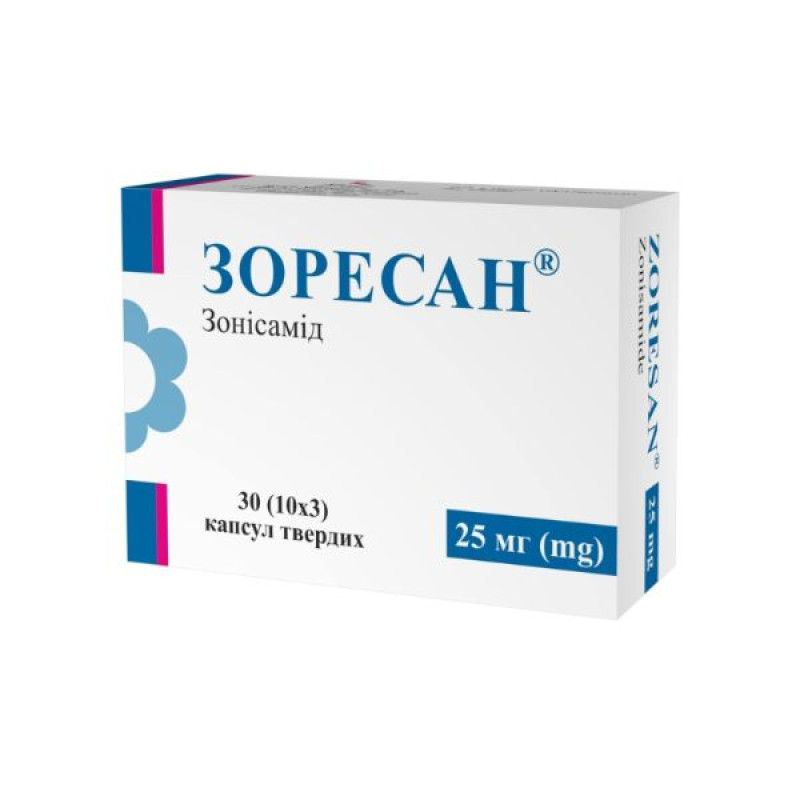Zoresan capsules 25 mg No. 30

Zoresan hard capsules are prescribed for the following indications:
Monotherapy in adult patients with partial seizures with or without secondary generalization, with newly diagnosed epilepsy; adjunctive therapy in adults and children over 6 years of age with partial seizures with or without secondary generalization.Composition
Active ingredient: zonisamide;
Each hard capsule contains zonisamide 25 mg or 50 mg, 100 mg;
Excipients: microcrystalline cellulose, sodium lauryl sulfate, colloidal silicon dioxide, hydrogenated castor oil;
Capsule shell:
for hard capsules of 25 mg or 50 mg gelatin, purified water, iron oxide yellow (E172), iron oxide black (E172), titanium dioxide (E171), sodium lauryl sulfate; for hard capsules of 100 mg gelatin, purified water, iron oxide red (E172), titanium dioxide (E171), sodium lauryl sulfate.Contraindication
Hypersensitivity to the active substance, to any of the excipients or to sulfonamides.
Method of application
The drug Zoresan® should be taken orally, regardless of meals.
Application features
Pregnant women
Zonisamide should not be used during pregnancy unless the physician considers that the potential benefit outweighs the potential risk to the fetus.
Children
The drug should be used in children aged 6 years and over and weighing more than 20 kg.
Drivers
Zonisamide has not been studied on the effects on the ability to drive and use machines. However, as some patients may experience drowsiness or difficulty concentrating, especially at the beginning of therapy or after increasing the dose, it is necessary to refrain from activities that require increased concentration, such as driving or operating other mechanisms.
Overdose
Symptoms: drowsiness, nausea, gastritis, nystagmus, myoclonus, coma, bradycardia, renal dysfunction, hypotension and respiratory depression. Since zonisamide has a long half-life, symptoms of overdose may be persistent. There is no specific antidote for the treatment of zonisamide overdose. In the event of an established or suspected overdose, gastric lavage or artificial induction of vomiting should be used in addition to the usual measures aimed at maintaining a patent airway.
Side effects
Infections and infestations: pneumonia, urogenital infections.
From the blood and lymphatic system: ecchymoses, agranulocytosis, aplastic anemia, leukocytosis, leukopenia, lymphadenopathy, pancytopenia, thrombocytopenia.
On the part of the immune system: hypersensitivity reactions, drug-induced hypersensitivity syndrome, DRESS syndrome (rash with eosinophilia and systemic symptoms).
Metabolic: anorexia, decreased appetite, hypokalemia, metabolic acidosis, renal tubular acidosis.
On the part of the psyche: agitation, irritability, confusion, depression, emotional lability, mood swings, acute psychosis, anxiety, insomnia, psychotic disorders, anger, rage, suicidal thoughts and suicide attempts, hallucinations.
Nervous system: ataxia, dizziness, memory impairment, drowsiness, bradyphrenia (slow thinking), attention deficit disorder, nystagmus, paresthesias, speech disorders, tremor, convulsions, amnesia, coma, grand mal seizures, myasthenic syndrome, neuroleptic malignant syndrome, epileptic status.
On the part of the organ of vision: diplopia, glaucoma, eye pain, myopia, blurred vision, decreased visual acuity.
Respiratory, thoracic and mediastinal disorders: dyspnea, aspiration pneumonia, respiratory distress, hypersensitivity pneumonitis.
Gastrointestinal: abdominal pain, constipation, diarrhea, dyspepsia, nausea, vomiting, pancreatitis.
From the liver and biliary tract: cholecystitis, cholelithiasis, hepatocellular damage.
Skin and subcutaneous tissue disorders: rash, pruritus, alopecia, anhidrosis, erythema multiforme, Stevens-Johnson syndrome, toxic epidermal necrolysis. Musculoskeletal and connective tissue disorders: rhabdomyolysis.
From the urinary system: nephrolithiasis, urolithiasis, hydronephrosis, renal failure, urine composition disorders.
General disorders and administration site conditions: fatigue, flu-like symptoms, fever, peripheral edema.
Interaction
In patients with epilepsy, long-term administration of zonisamide at therapeutic doses has no clinically significant effect on the pharmacokinetics of carbamazepine, lamotrigine, phenytoin and sodium valproate.
Storage conditions
Store in the original packaging at a temperature not exceeding 25 ° C. Keep out of the reach of children.
Shelf life - 2 years.
There are no reviews for this product.
There are no reviews for this product, be the first to leave your review.
No questions about this product, be the first and ask your question.




